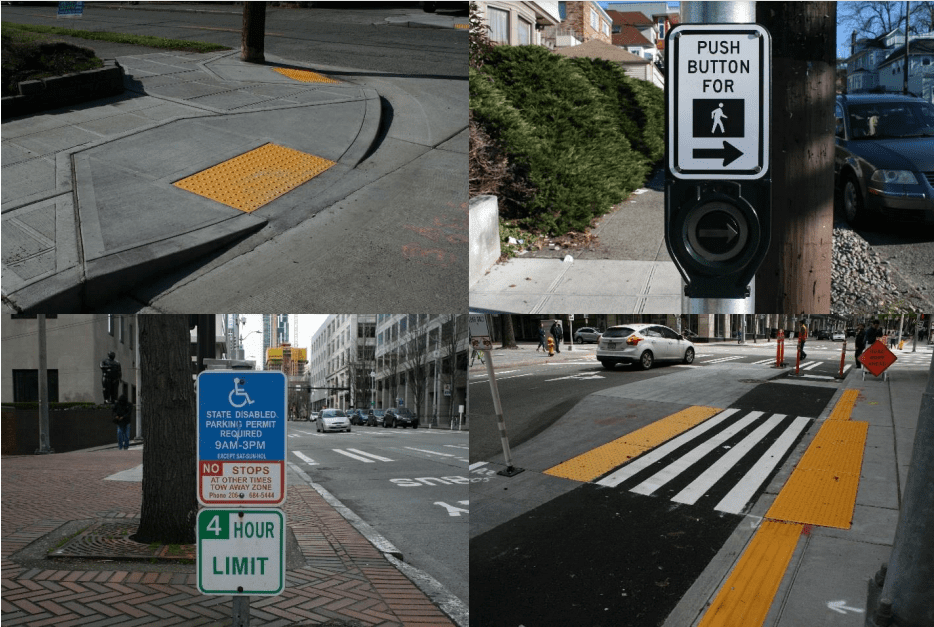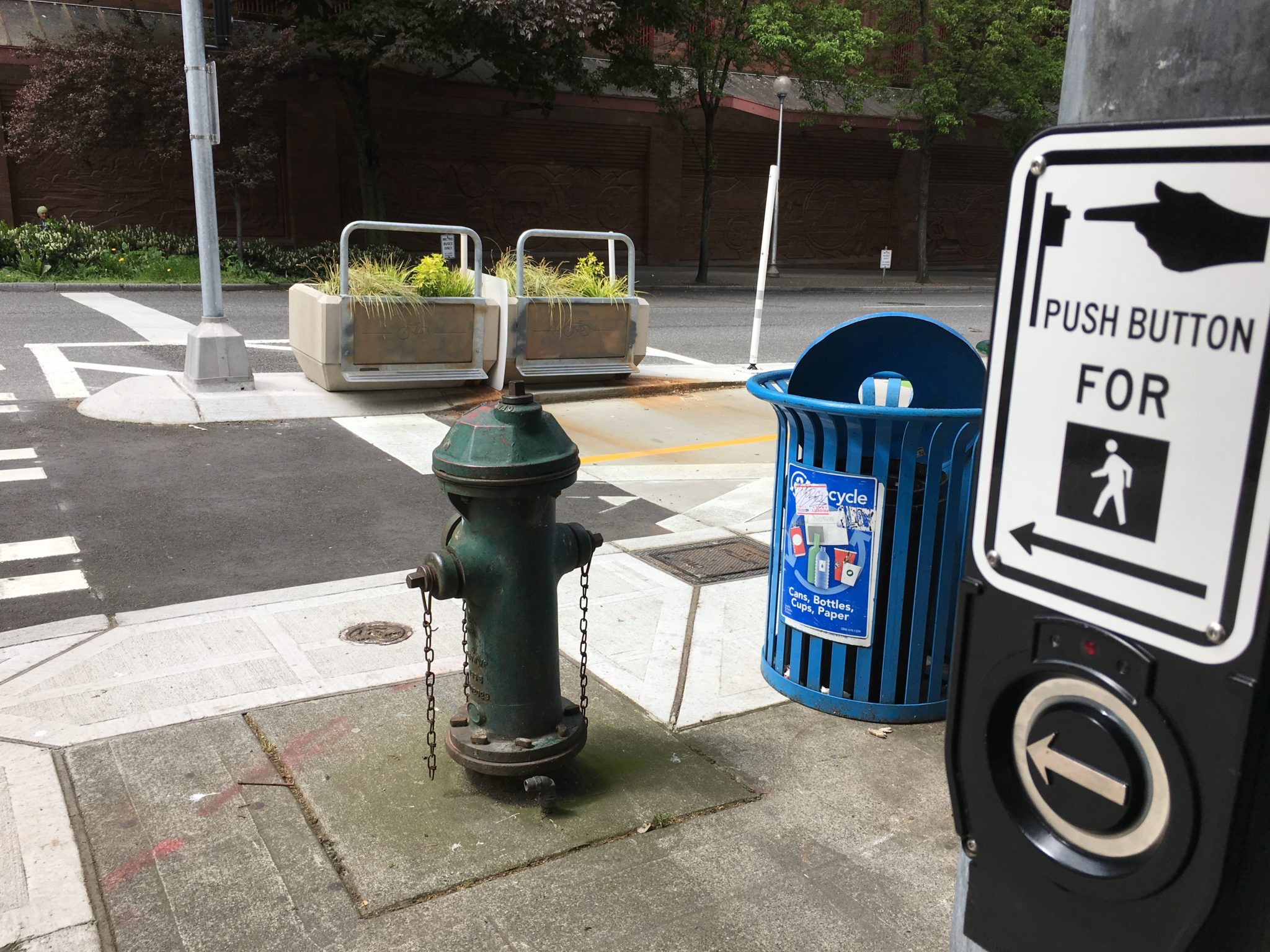 Clockwise from top left: a curb ramp; an Accessible Pedestrian Signal; tactile features at a bike lane crossing; a disabled parking sign. These are some measures we install to improve accessibility in the public right-of-way. Photo credit: SDOT
Clockwise from top left: a curb ramp; an Accessible Pedestrian Signal; tactile features at a bike lane crossing; a disabled parking sign. These are some measures we install to improve accessibility in the public right-of-way. Photo credit: SDOT Last week was the 32nd anniversary of the passage of the Americans with Disabilities Act (ADA). In honor of this important milestone, let’s talk about our work to make Seattle’s transportation system more accessible for people of all ages and abilities.
First, some background: the ADA is a federal law that prohibits discrimination against people with disabilities. It is also a civil rights law ensuring that people with disabilities have equal rights and opportunities. Thanks to the ADA, all public entities need to ensure their services, programs, or activities are accessible to people with disabilities.
At SDOT, our ADA Program is responsible for planning and making improvements that help people of all abilities have access to Seattle’s sidewalks. Our infrastructure includes elements like sidewalks, parking, transit stops, and more. Features such as curb ramps, detectable warnings, and street crossings are important parts of making our pedestrian network accessible.
Many of our accessibility improvements, such as sidewalk repairs, new curb ramps, and accessible pedestrian signals, are made possible through the Levy to Move Seattle. Large Levy-funded projects, like the ones we recently completed on 15th Ave S and 15th Ave NE, also contain a variety of accessibility improvements. Thanks to you, we can make Seattle a better and safer place to walk and roll.
Our work to improve accessibility and inclusion within public spaces is broad and ongoing. We thought it might be helpful to highlight some ways these measures show up in the day-to-day. The next time you’re traveling, look out for some of the following:
Curb ramps

A curb ramp is a slope cut into the sidewalk down to the level of the street. Curb ramps help people using wheelchair and other mobility aids to move from sidewalks into crosswalks or other parts of the street. Curb ramps also feature a high contrast (typically yellow), raised, tactile surface. These surfaces alert people with visual disabilities that a pedestrian area is transitioning to a potential hazard area, such as a street crossing, parking area, or transit boarding location.
Our goal is to add at least 1,250 accessible curb ramps to Seattle sidewalks each year. This year, we’re on pace to significantly exceed that goal and have already built nearly 1,000 curb ramps. Many of these curb ramps are built as a part of major paving projects, for example last year we built nearly 450 curb ramps as a part of the Green Lake and Wallingford multimodal improvements project. We also build at least 150 curb ramps each year based on requests from the public. Most of this work is funded by the Levy to Move Seattle, and we also require private developers to build accessible curb ramps as a part of any private construction which they are performing on the sidewalk.
There are eight standard curb ramp designs. But more often than not, a standard curb ramp isn’t feasible given the layout or topography of the street, or other impediments such as utility infrastructure or limited space in the public right-of-way. In this case, we use a combination of options to improve accessibility, including (but not limited to):
- Combination of Curb Ramp Designs (Non-Standard): When a standard curb ramp design is not feasible, we may design a custom curb ramp to provide adequate access to a crosswalk. This could involve modifying a standard curb ramp detail or blending two or more details together.
- Curb bulbs: Curb bulbs extend the sidewalk into the street, reducing the time and distance it takes a pedestrian to cross while making them more visible to drivers. Curb bulbs can also prevent drivers from parking in front of crosswalks or blocking curb ramps.
- Raised crosswalks: A raised crosswalk brings the elevation of the roadway up to meet the sidewalk. The sidewalk intersecting the street must include a detectable warning surface to comply with current ADA standards.
Accessible sidewalks

What makes a sidewalk accessible? A lot of things! For a sidewalk to be usable by people of all abilities, it needs to be:
- As level as possible. Typically, a 2% slope is considered level while also allowing water to drain off the sidewalk.
- Clear of obstructions and free from overhanging objects such as signs and branches.
- Firm and stable, with a slip-resistant surface.
- Maintained, with few cracks and minimal damage greater than a half inch (rounded at the top).
We also sometimes add additional tactile features on sidewalks and walking paths. These help people to remain in the designated paths and out of the way of bikes, vehicles, or transit.

The majority of new sidewalks in Seattle are constructed through private development. When we do build new sidewalks, such as through the New Sidewalks Levy-funded program, we build them to strict standards of accessibility.
When it comes to the city’s currently existing sidewalks and curbs, our Sidewalk Repair Program oversees the maintenance. However, adjacent property owners share with the City the responsibility to keep sidewalks in good repair and safe for public travel. This includes keeping sidewalks clear of obstructions like vegetation overgrowth or snow and ice.
In the first two quarters of 2022, we’ve completed more than 11,000 sidewalk spot improvements funded by the Levy to Move Seattle’s sidewalk repair program. We also complete sidewalk improvements through other programs too, including all major paving projects. Improvements and repairs include placing a small patch of asphalt over cracks or uplifts on sidewalks to create a smooth surface or repair curbs.
Accessible Pedestrian Signals

Accessible Pedestrian Signals make street crossings more usable for people who have low vision, are blind, or are Deaf-Blind. Many features go into making the push button accessible, including:
- Sounds: a voice or tone lets the pedestrian know when the walk sign has turned on and it is safe to cross the street.
- Vibrations: the button buzzes to let the pedestrian feel when the walk sign has turned on.
- Clear ground space: the area around the button is clear of obstructions, so pedestrians can approach it.
- Close reach range: the push button must be between 15 and 48 inches from the ground so people of all ages can reach it.
Our ADA program aims to install accessible pedestrian signals in at least 10 locations every year. We often choose these locations based on requests we receive through our customer service request process. Generally, our priority is to install APS devices in areas where they will benefit the greatest number of people with disabilities.
Do you want to discuss how SDOT can improve your mobility around the Seattle’s streets and sidewalks? Do you need more curb ramps in your neighborhood? Do you like the tactile features on your nearby walking path? Is there anything else that might make you feel more safe or comfortable traveling through your community?
We want to hear from you. Please send your comments to SDOT ADA Coordinator Tom Hewitt at 206-615-1974 or by email at Tom.Hewitt@Seattle.gov. Finally, you may make an ADA request online here.
Our goals and values
Beyond it just being a legal requirement, we strive to improve accessibility and inclusion within the public right-of-way because it’s the right thing to do. And our pedestrian infrastructure is just one area we do this work in—there are many others not covered in this blog post.
In alignment with our key values and goals – equity, sustainability, livability, mobility, safety, and excellence – we’re going to keep working with you, Seattle community members, to learn how we can do better and improve accessibility in all our projects.
Check out some additional resources below to learn more about the past, present, and future of accessibility work at SDOT:
- The Seattle Pedestrian Master Plan (PMP) is a 20-year blueprint to achieve our vision of Seattle as the most walkable and accessible city in the nation. We closely align our ADA Program’s planned improvements with the PMP.
- The Seattle Accessible Route Planner is intended to help people plan travel routes using City curb ramps and sidewalks.
- In 2020, we published our Americans with Disabilities Act (ADA) Transition Plan Update for the Seattle Public Right-of-Way. This update is intended to help us identify and prioritize ongoing accessibility improvements.
- You can make an accessibility improvement request for your neighborhood online here.


Thank you for taking the time to learn more about these accessibility measures! Public awareness and understanding of ADA standards are an important part of helping to make Seattle more accessible for everyone.